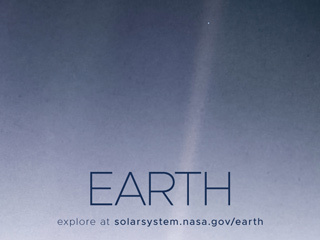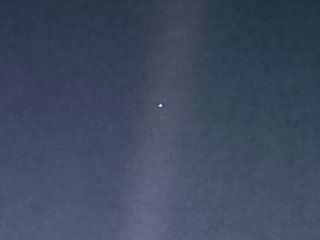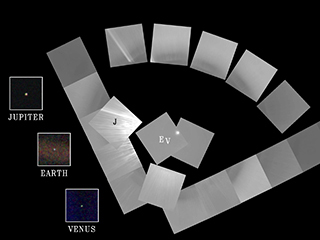5 Things You Didnt Know About the Dark Voyager
Xxx years ago on Feb. 14, 1990, NASA'due south Voyager 1 spacecraft sent domicile a very special Valentine: A mosaic of sixty images that was intended as what the Voyager team called the get-go "Family Portrait" of our solar arrangement.
The spacecraft was out beyond Neptune when mission managers commanded it to expect back for a last fourth dimension and snap images of the worlds it was leaving backside on its journey into interstellar infinite.
Information technology captured Neptune, Uranus, Saturn, Jupiter, Earth and Venus. A few key members didn't make the shot: Mars was obscured past scattered sunlight billowy around in the camera, Mercury was too close to the Sun and dwarf planet Pluto was also tiny, too far away and too dark to be detected. But the images gave humans an awe-inspiring and unprecedented view of their dwelling world and its neighbors.
I of those images, the moving-picture show of World, would get known as the "Pale Blue Dot." The unique view of Globe every bit a tiny speck in the cosmos inspired the title of scientist Carl Sagan's book, "Pale Bluish Dot: A Vision of the Human Future in Space,"
But the image almost didn't happen.
Here are 10 things yous might not know about Voyager i's famous Pale Blue Dot photograph.
ane. Not in the Plan
Neither the "Family unit Portrait" nor the "Pale Blue Dot" photo was planned equally part of the original Voyager mission. In fact, the Voyager team turned down several requests to take the images considering of express engineering resources and potential danger to the cameras from pointing them close to the Dominicus. Information technology took eight years and six requests to get approval for the images.
ii. A Unique Perspective
Voyager i remains the first and merely spacecraft that has attempted to photograph our solar system. Only three spacecraft take been capable of making such an observation: Voyager 1, Voyager ii and New Horizons. (Pioneer x and Pioneer 11 — the other two spacecraft headed into interstellar space — had similar vantage points, but technical challenges prevented them from getting such a shot.)
3. A Mote of Dust
The Voyager imaging squad wanted prove Earth'south vulnerability — to illustrate how fragile and irreplaceable it is — and demonstrate what a pocket-sized identify it occupies in the universe. Earth in the prototype is just almost a single a pixel, a pale blue dot.
iv. A Happy Coincidence
The image contains scattered light that resembles beams of sunlight, making the tiny Earth announced fifty-fifty more dramatic. In fact, these sunbeams are camera artifacts that resulted from the necessity of pointing the camera within a few degrees of the Dominicus.
Voyager ane was forty astronomical units from the Sun at the time so Earth appeared very almost our brilliant star from Voyager's vantage bespeak. 1 astronomical unit is 93 1000000 miles, or 150 1000000 kilometers That one of the rays of light happened to intersect with Earth was a happy coincidence.
Wait again at that dot. That'due south hither. That'south habitation. That's us.
5. Carl Sagan's Dream Shot
The prominent planetary scientist Carl Sagan (1934-1996) — a member of the Voyager imaging team — had the original thought to use Voyager'southward cameras to image Earth in 1981, following the mission'due south encounters with Saturn. Sagan subsequently wrote in poetic particular about the image and its meaning in his book, "Pale Blue Dot: A Vision of the Human Future in Space."
"Expect once again at that dot." Sagan wrote. "That'south here. That's home. That's united states of america."
6. Cold Cameras
Voyager i powered upwards its cameras for the images on February. 13 and it took iii hours for them to warm up. The spacecraft's onboard tape recorder saved all the images taken, for later on playback to Earth.
7. Light Time
The images of Earth snapped by Voyager 1 captured light that had left our planet five hours and 36 minutes earlier. (This was, of class, reflected sunlight that had left the Sun eight minutes before that.)
viii. Downloading...
Voyager 1 was so far from Globe it took several communications passes with NASA's Deep Space Network, over a couple of months, to transmit all the data. The last of the epitome information were finally downloaded on World on May 1, 1990.
9. Another Unique Perspective
Voyager 1 as well took the offset image of the unabridged World and Moon together well-nigh the start of its mission on Sept. eighteen, 1977. The images were taken 13 days afterwards launch at a altitude of nigh seven.3 million miles (11.66 million kilometers) from Earth.
ten. Parting Shot
Later on taking the images for "The Family Portrait" at 05:22 GMT on Feb. xiv, 1990, Voyager one powered downward its cameras forever. As of early 2020 the spacecraft is nevertheless operating, just no longer has the adequacy to take images.
Read More
› The Story Behind Voyager 1's Pale Blue Dot
› The Story Behind Voyager 1's Family unit Portrait
› Ready-to-Print Pale Blue Dot Poster
› The Full Set of NASA Planetary Posters
› Voyager 1: In Depth
› Voyager 2: In Depth
Acknowledgements: Amanda Barnett, Phil Davis and Preston Dyches contributed to this story. Some of the data in this article came from the account of the solar system family portrait detailed in Kosm ann , Hansen and Sagan, "The Family Portrait of the Solar System: The last prepare of images taken by Voyager i and the fascinating story of how they came to be," 70th International Astronautical Congress (IAC), IAC-19-F4.ane.eight, 2019.
hollomonlaing1951.blogspot.com
Source: https://solarsystem.nasa.gov/news/1175/10-things-you-might-not-know-about-voyagers-famous-pale-blue-dot-photo/



Post a Comment for "5 Things You Didnt Know About the Dark Voyager"